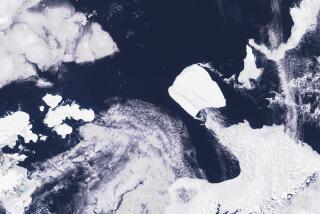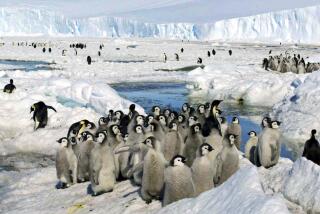Penguins Threatened by Iceberg Weather Changes
- Share via
Two massive icebergs in Antarctica’s Ross Sea have altered local weather conditions enough to endanger some of the continent’s penguin breeding colonies, according to the National Science Foundation.
A small colony of Adelie penguins at Cape Royds will “fail totally” this year, according to biologist David Ainley of H.T. Harvey & Associates of San Jose, an ecological consulting firm.
The numbers at a larger colony at Cape Crozier--normally about 130,000 breeding pairs--”are on the low side” of the normal range this year, he added. Many pairs are unable to reach the breeding grounds because of the abnormally large amounts of sea ice.
Meanwhile, a small colony of about 1,200 emperor penguins at Cape Crozier failed to raise any chicks, according to Gerald Kooyman of the Scripps Institution of Oceanography. The birds probably abandoned efforts to breed when the icebergs, pushing southward, destroyed and closed off their usual breeding area, he said. The few chicks that were conceived either died in the egg or soon after birth.
The icebergs are designated B-15A and C-16. B-15A is about 23 miles wide by 54 miles long, while C-16 is 11.5 miles wide by 34 miles long. Both broke away from the Ross Ice Shelf in March 2000 and gradually migrated west to a point northeast of McMurdo Sound, creating a barrier that altered wind and current patterns.
As a result, sea ice earlier this season extended nearly 80 miles north of McMurdo Station, the main U.S. research station in Antarctica. Normally, the ice edge extends only 15 to 20 miles north of the station. Recent storms have reduced the extent of the ice greatly--it is currently summer in the southern hemisphere--but the change comes too late to do the penguins much good.
The extensive ice earlier in the year increased the distance between the breeding colonies and their food sources in the open sea. And instead of swimming to food, the penguins had to walk across the ice--a much slower process. The birds walk at speeds up to 1 mph but swim as fast as 5 mph.
Researchers expect the colonies to bounce back but will be monitoring their progress.
More to Read
Sign up for Essential California
The most important California stories and recommendations in your inbox every morning.
You may occasionally receive promotional content from the Los Angeles Times.













